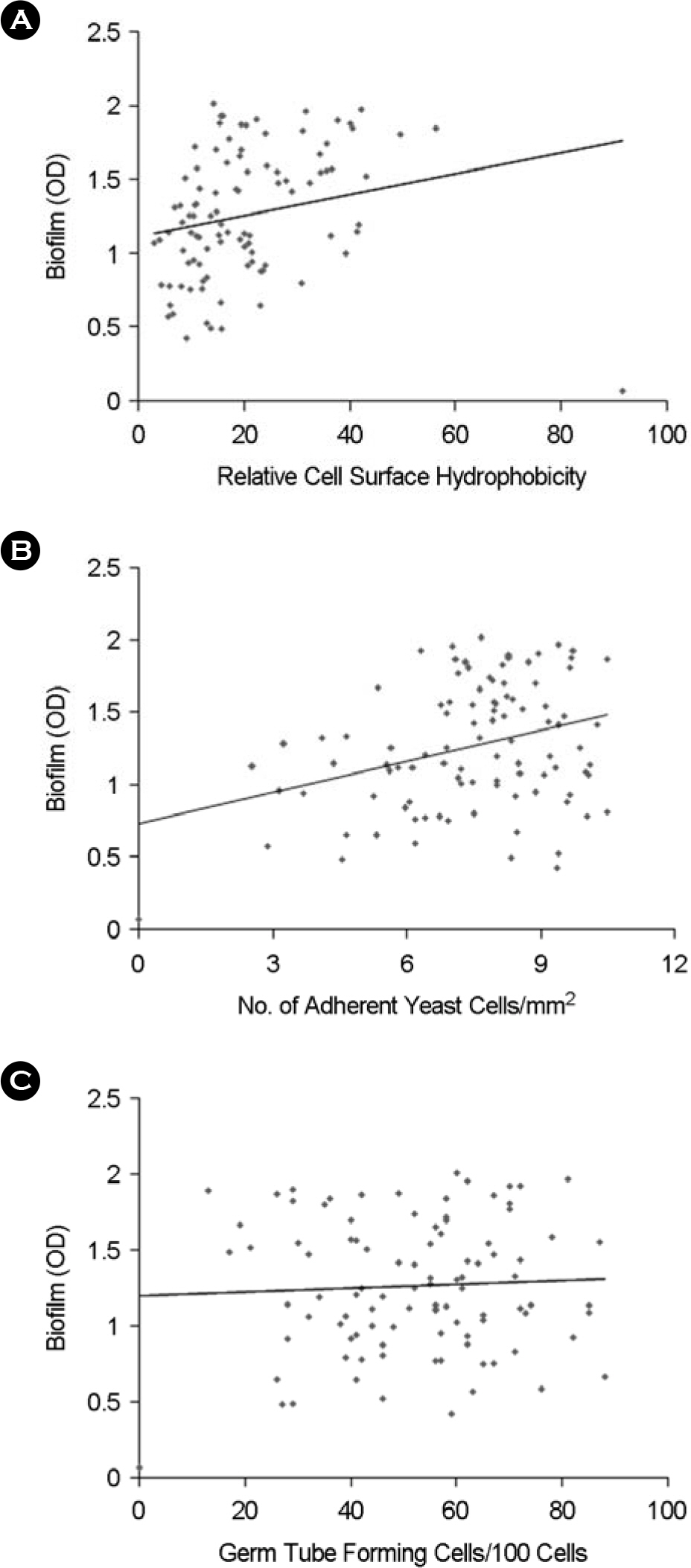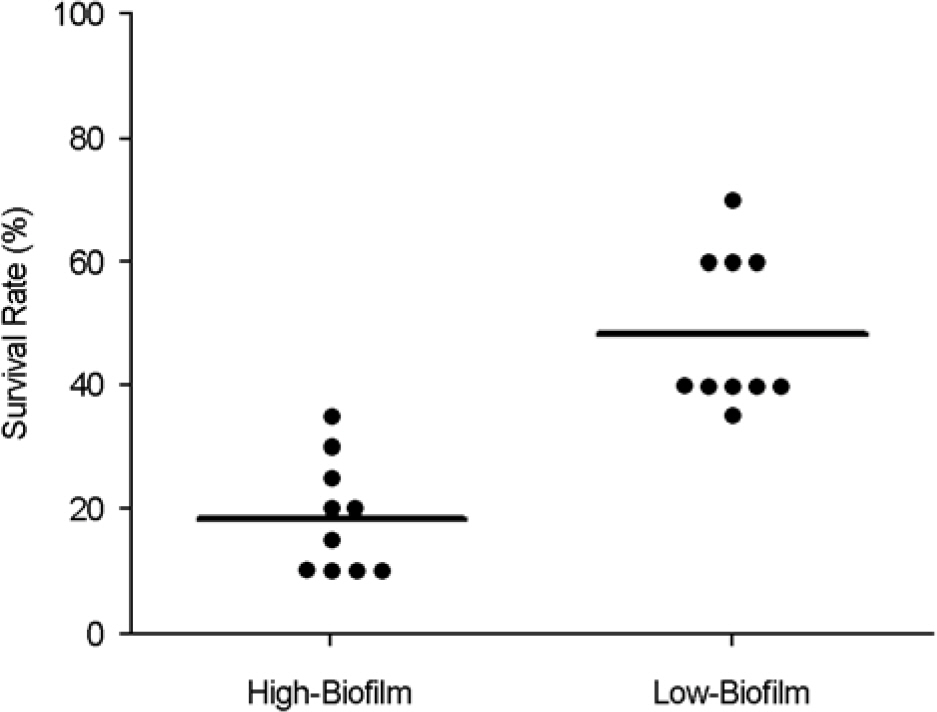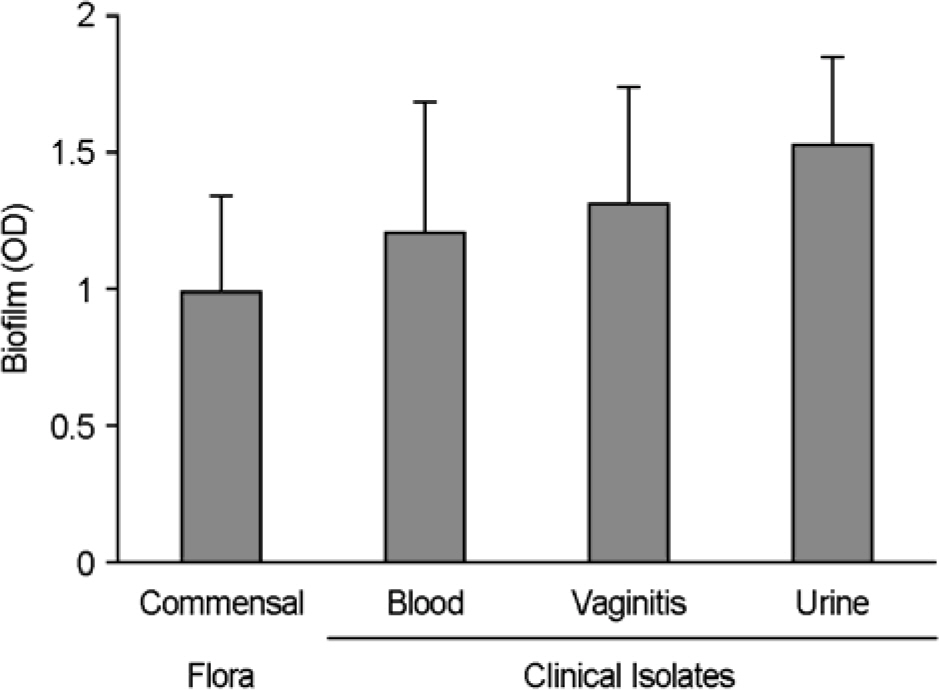J Bacteriol Virol.
2009 Jun;39(2):119-124. 10.4167/jbv.2009.39.2.119.
Relationship between Biofilm Formation Ability and Virulence of Candida albicans
- Affiliations
-
- 1Department of Microbiology, Yonsei University Wonju College of Medicine and Institute of Basic Medicine, Yonsei University, Wonju, Korea. leekh@yonsei.ac.kr
- 2Department of Microbiology, Kwandong University College of Medicine, Kangnung, Korea.
- 3Department of Laboratory medicine, Kwandong University College of Medicine, Myongji Hospital, Goyang, Korea.
- 4Department of Infectious Disease, Kwandong University College of Medicine, Myongji Hospital, Goyang, Korea.
- KMID: 1474172
- DOI: http://doi.org/10.4167/jbv.2009.39.2.119
Abstract
- Biofilms are microbial communities that form on a surface and are surrounded by extracellular polymeric substances. Candida biofilms are a cause of infections associated with medical devices. In the present study, an attempt was made to evaluate a significance of biofilm formation ability (BF) in virulence of C. albicans. C. albicans of 98 isolates, 24 commensal strains obtained from the oral cavities of healthy volunteers, 29 from blood culture, 25 from urine culture, and 20 from vaginal candidiasis, were assayed for BF, an ability to adhere to epithelial cells (ADH), cell surface hydrophobicity (CSH), and germ tube forming rate (GT). The relationships of BF with CSH, ADH, and GT were statistically examined. A positive correlation between BF and ADH was obtained, but the correlation (r=0.326) was relatively low. To assess BF as a factor contributing for candidiasis, mice lethality test was performed. The 10 isolates with the highest BF (mean survival rate, 24%) allow to kill mice more than those with the 10 lowest BF (mean survival rate, 47%). In addition, clinical strains isolated from blood culture, urine culture, and vaginal candidiasis showed higher BF than oral commensal strains. These results suggest BF may represent a virulent characteristic of C. albicans.
Keyword
MeSH Terms
Figure
Reference
-
1). Pappas PG, Rex JH, Sobel JD, Filler SG, Dismukes WE, Walsh TJ, Edwards JE; Infectious Diseases Society of America. Guidelines for treatment of candidiasis. Clin Infect Dis. 2004. 38:161–89.2). Hurley R., de Louvois J., Mulhall A. Yeasts as human and animal pathogens. Rose AH, Harrison JS, editors. editors.The yeasts. 2nd ed.London: Academic Press INC;1987. p. 212 39.3). Calderone R., Gow NAR. Host recognition by Candida species. Calderone RA, editor. editor,. Candida and candidiasis. Washington D.C.: ASM Press;2002. p. 67–86.4). Hostetter MK. Adhesins and ligands involved in the interaction of Candida spp. with epithelial and endothelial surfaces. Clin Microbiol Rev. 1994. 7:29–42.5). Sundstrom P. Adhesion in Candida spp. Cell Microbiol. 2002. 4:461–9.6). Hube B., Naglik J. Candida albicans proteinases: resolving the mystery of a gene family. Microbiology. 2001. 147:1997–2005.7). Hube B., Naglik JR. Extracellular hydrolases. Calderone RA, editor. editor,. Candida and candidiasis. Washington D.C.: ASM Press;2002. p. 107–22.8). Brown AJ., Gow NA. Regulatory networks controlling Candida albicans morphogenesis. Trends Microbiol. 1999. 7:333–8.9). Gow NA., Brown AJ., Odds FC. Fungal morphogenesis and host invasion. Curr Opin Microbiol. 2002. 5:366–71.
Article10). Soll DR. Gene regulation during high-frequency switching in Candida albicans. Microbiology. 1997. 143:279–88.11). Soll DR. Phenotypic switching. Calderone RA, editor. editor,. Candida and candidiasis. Washington D.C.: ASM Press;2002. p. 123–42.12). Kojic EM., Darouiche RO. Candida infections of medical devices. Clin Microbiol Rev. 2004. 17:255–67.13). Ramage G., Martínez JP., Lípez-Ribot JL. Candida biofilms on implanted biomaterials: a clinically significant problem. FEMS Yeast Res. 2006. 6:979–86.14). Seneviratne CJ., Jin L., Samaranayake LP. Biofilm lifestyle of Candida: a mini review. Oral Dis. 2008. 14:582–90.15). Ramage G., Vandewalle K., Wickes BL., Lopez-Ribot JL. Characteristics of biofilm formation by Candida albicans. Rev Iberoam Micol. 2001. 18:163–70.16). Baillie GS., Douglas LJ. Matrix polymers of Candida biofilms and their possible role in biofilm resistance to antifungal agents. J Antimicrob Chemother. 2000. 46:397–403.17). Andes D., Nett J., Oschel P., Albrecht R., Marchillo K., Pitula A. Development and characterization of an in vivo central venous catheter Candida albicans biofilm model. Infect Immun. 2004. 72:6023–31.18). Rosenberg M. Microbial adhesion to hydrocarbons: twenty-five years of doing MATH. FEMS Microbiol Lett. 2006. 262:129–34.
Article19). Chaffin WL., López-Ribot JL., Casanova M., Gozalbo D., Martínez JP. Cell wall and secreted proteins of Candida albicans: identification, function, and expression. Microbiol Mol Biol Rev. 1998. 62:130–80.20). Li X., Yan Z., Xu J. Quantitative variation of biofilms among strains in natural populations of Candida albicans. Microbiology. 2003. 149:353–62.
- Full Text Links
- Actions
-
Cited
- CITED
-
- Close
- Share
- Similar articles
-
- Influence of Bacterial Presence on Biofilm Formation of Candida albicans
- Candida albicans Biofilm Formation and Pathophysiology
- Proteus vulgaris and Proteus mirabilis Decrease Candida albicans Biofilm Formation by Suppressing Morphological Transition to Its Hyphal Form
- Biofilm-forming ability and adherence to poly-(methyl-methacrylate) acrylic resin materials of oral Candida albicans strains isolated from HIV positive subjects
- Influence of Cell Surface Hydrophobicity on Adhesion and Biofilm Formation in Candida albicans and Several Bacterial Species




